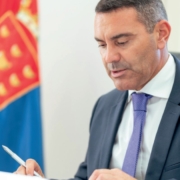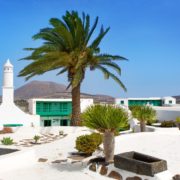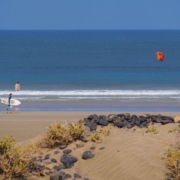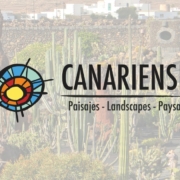After 12 years as Teguise Mayor, Oswaldo Betancort became the President of Lanzarote’s island government, the Cabildo, in 2023, where his party, the Coalición Canaria, currently rules with the support of the Partido Popular. We recently had the opportunity to interview him and will be publishing his responses over the next two issues. In the first instalment, we address new projects, the water crisis, transport and the environment:
What are the most important projects for the Cabildo during this term?
Our commitment as a governing group is clear: to transform the structural problems we have inherited into real solutions for the people of Lanzarote and La Graciosa. There have been many words, much rhetoric, but no action. Lanzarote and La Graciosa can no longer wait.
We have already drafted the Island Development Plan for Lanzarote and the Chinijo Archipelago, which is currently undergoing public consultations. We have also made progress on important documents such as the Natural Resources Management Plan for the Volcanoes and the Special Plan for La Geria, among others.
We’ve established a very clear roadmap to tackle the water crisis and have promoted specific projects and works to modernize our outdated network and reduce losses, and increase water production by 20,000 cubic meters per day. We are also recovering key investments: €25 million for agricultural irrigation, with an independent water network for our farmers, and an additional €37.5 million to renovate the treatment plants.
Our commitment to a quality tourism model is firm. We have eliminated around 2,000 expired tourist beds, we’re reviewing the legality of many holiday rentals, and we are controlling the influx of tourists to our natural areas, such as the successful pilot scheme for shuttle buses in Caldera Blanca and Volcán del Cuervo.
Along with all this, I’d like to highlight a historic achievement in this term: after years of incomprehensible disputes with the associations that care for the most vulnerable in our society, we have reached agreement and signed the Social Agreements, strengthening collaboration with NGOs with an investment of €35.5 million. And we’ve made real progress on much-needed infrastructure projects that had stalled, such as the new Tahiche Residence for the Elderly and the Cáritas Comprehensive Social Care Centre, whose construction will begin in the coming months. These are projects that make a difference, that improve people’s lives, that look to the future with responsibility, vision, and commitment to the residents of Lanzarote and La Graciosa.
If the contract with Canal Gestión is terminated, what will happen? How will the necessary investment for Lanzarote’s water system be secured?
Canal Gestión hasn’t made any investments on our island for years. The water infrastructure that’s being processed, put out to tender, and implemented during this term is being financed with subsidies from the Canarian Government, the state government, and Lanzarote’s Cabildo itself. In addition, the Water Consortium has its own resources from the profits generated by wind farms.
The service managed by the Water Consortium falls under the jurisdiction of local councils and the Cabildo itself. If financial contributions are needed to cover the infrastructure, they will be allocated in proportion to their share.
It’s worth remembering that last April’s Extraordinary General Meeting of the Water Consortium unanimously approved a process to terminate the contract with Canal Gestión for the water supply, sanitation, and reuse services for the islands of Lanzarote and La Graciosa. This does not mean that water management will ultimately have to be outsourced, but the Consortium could not stand idly by in the face of the company’s serious breaches of contract. Now, we have an eight-month deadline and must have all options prepared, with neither public management nor the creation of a public-private joint venture being ruled out.
Can anything be done to prevent a repeat of the floods that hit Costa Teguise and Arrecife in April?
Recently, we secured the collaboration of the Government of the Canary Islands to fund, with one million euros, stormwater drainage works in both Arrecife and Costa Teguise, the two areas most affected by the torrential rainfall suffered on April 12.
These projects are specific actions to improve urban stormwater drainage in the Argana area of Arrecife and to reduce the flow of stormwater collected by the basins that flow into the Barranco del Hurón, which empties out in Costa Teguise. As well as reducing storm damage, these actions will also prevent soil erosion in agricultural areas.
Lanzarote continues to depend on imported fossil fuels. Less than 9% of the island’s energy comes from wind farms, and solar energy accounts for even less. Many visitors are surprised by the lack of solar turbines and panels. Is Lanzarote failing in the transition to renewable energy?
Lanzarote has great potential for installing renewable energy, but unfortunately, as a result of the previous government’s neglect, we currently only have a clean energy penetration of between 11% and 14%, lower than the regional average and far below the targets we must meet, set by the National Integrated Energy and Climate Plan, which aims for 58% by 2030.
Faced with this situation, the first thing we did as soon as we came to power was to update all our wind farms, which had no maintenance contracts.
This governing group is taking firm and decisive steps in the transition toward a more sustainable energy model. And we are doing so with actions, not promises. After more than eight years of blockage, we recently managed to launch the San Bartolomé wind farm, a strategic infrastructure with 9.2 MW of capacity that could supply approximately 5,000 homes and which significantly increases renewables in our electricity system.
Thanks to the five wind farms operating on the island—Arrecife, Teguise I, Punta Grande, Los Valles, and now San Bartolomé— Lanzarote has a total wind power capacity of 40.7 MW, allowing us to reach peaks of 35% clean energy coverage in the Lanzarote-Fuerteventura electricity system.
I’m aware that there is still a long way to go, and that the climate and landscape of our island impose certain limitations. But what was once an island bogged down in paperwork and stalled projects is now moving again. The energy transition won’t be resolved overnight, but since I assumed the presidency of the Cabildo, we have reactivated stalled projects, strengthened institutional collaboration, and are allocating real investments to turn Lanzarote and La Graciosa into benchmarks for sustainability. It will be the people of Lanzarote, through their institutions, who will decide where these renewable energy projects will and will not be implemented.
How can we reduce car dependence in Lanzarote?
The solution lies in changing the island’s mobility model, which involves, among other initiatives, strengthening the public transport offering. In Lanzarote, we’ve taken very important steps: creating three new strategic bus lines, incorporating 23 new hybrid buses, and adding almost 600 additional intercity routes. An investment of more than €2 million has also been approved to guarantee free public transport for Canarian residents.
But this won’t be enough unless we rethink how we get around. At the Cabildo, we’re promoting a sustainable mobility strategy that includes restrictions on private vehicles, such as parking management, and measures to promote other forms of transport. In the last two years, public transport use has grown by 70% on our island, demonstrating that when the service is improved, citizens respond. Reducing car dependence means designing an island built for people, not vehicles.











Leave a Reply
Want to join the discussion?Feel free to contribute!